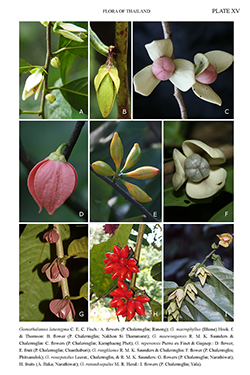e-Flora of Thailand
Volume 16 > Part 1 > Year 2022 > Page 130 > Annonaceae > Goniothalamus
10. Goniothalamus macrophyllus (Blume) Hook.f. & Thomsonwfo-0000706521
Fl. Ind. 109. 1855, in nota; Miq., Fl. Ind. Bat. 1(2): 28. 1858; Miq., Ann. Mus. Bot. Ludguno-Batavi 2: 35. 1865; Scheff., Natuurk. Tijdschr. Ned.-Indië 31: 13. 1870; Hook.f. & Thomson, Fl. Brit. India 1: 74. 1872; King, J. Asiat. Soc. Bengal, Pt. 2, Nat. Hist. 61: 76. 1892, Ann. Roy. Bot. Gard., Calcutta 4: 97. 1893; Backer, Schoolfl. Java, 33. 1911; Ridl., Fl. Malay Penins. 1: 66. 1922; J.Sinclair, Gard. Bull. Singapore 14: 446. 1955; Backer & Bakh. f., Fl. Java 1: 112. 1963; Chalermglin, Fam. Annon. 166. 2001; R.M.K.Saunders, Bot. J. Linn. Soc. 139: 248. 2002; I.M.Turner et al. in Soepadmo et al., eds., Tree Fl. Sabah & Sarawak 8: 52. 2014; S.Gardner et al., Forest Trees S. Thailand 1: 109. 2015.— Unona macrophylla Blume, Bijdr. Fl. Ned. Ind. 17. 1825.— Polyalthia macrophylla (Blume) Blume, Fl. Javae 2 (Anonaceae): 79, fig. 39. 1830. Plate XV: B.
Accepted Name : This is currently accepted.
Synonyms & Citations :
Description : Tree to 5 m tall. Young branches glabrous to hairy. Leaves (sub)coriaceous, elliptic to obovate, 26–59 by 6–15.5 cm, matt above, glabrous to very sparsely hairy below, (sub)glabrous above, secondary veins 12–23 pairs, ± plane to impressed above; tertiary venation percurrent, (±) distinct; petioles 6–28 mm long. Flowers solitary (rarely paired), on trunk or branches, pedicels 5–11.5 mm long. Sepals 6–30 by 4–12.5 mm, not reflexed, venation sometimes distinct. Outer petals cream-white, 10–28 by 4.5–11.5 mm, (very sparsely) hairy abaxially, subglabrous to sparsely hairy adaxially with velutinous basal region facing apertures between inner petals, venation indistinct. Inner petals cream-white, 7–15 by 4–9 mm, (sparsely) hairy abaxially, velutinous adaxially. Stamens 65–180, anther connective apex short- to long-apiculate. Carpels 11–36, ovaries glabrous to densely hairy; stigmas funnel-shaped, very sparsely to densely hairy. Fruits without persistent sepals, pedicels 7–19 mm long. Monocarps red, orange or yellowish, subglobose to ellipsoid, 0.8–1.5 by 0.75–1 cm, apiculate, smooth, (very) sparsely hairy, stipe to 1.8 mm long. Seeds 1(–2), 8.5–12 by 6.5–8.5 mm, smooth to slightly rugose, glabrous to hairy.
Thailand : SOUTH-WESTERN: Phetchaburi; PENINSULAR: Ranong (Khlong Kampuam – type of Goniothalamus macrophyllus var. kerrii Bân: Kerr 16887, holotype -BM), Phangnga, Nakhon Si Thammarat (Khao Luang – type of G. macrophyllus var. siamensis J.Sinclair: Smitinand 821, holotype -BKF), Trang, Satun, Songkhla, Yala, Narathiwat.
Distribution : Peninsular Malaysia, Singapore, Sumatra, Borneo, Java (type).
Ecology : Variably dry or wet, primary and secondary, lowland to submontane forests, with loamy, clay or sandy soils, over granite, sea level to 1,300 m alt. Flowering and fruiting throughout the year.
Vernacular : King dok diao (กิ่งดอกเดียว)(Trang); ratcha khru dam (ราชครูดำ)(Pattani).
Notes: Goniothalamus macrophyllus is the most widespread species in the genus, and is very well represented in herbaria. The leaves have a characteristic and diagnostically important “granular” appearance below because of the immersed tertiary and higher-order veins. This character alone is sufficient to distinguish G. macrophyllus from all other Goniothalamus species in Thailand except G. rotundisepalus and G. tavoyensis. There is considerable diversity in leaf shape within G. macrophyllus, ranging from narrowly to broadly elliptic and obovate.
E-version notes : As Goniothalamus macrophyllus (Blume) Zoll., Linnaea 29: 313. 1858.

